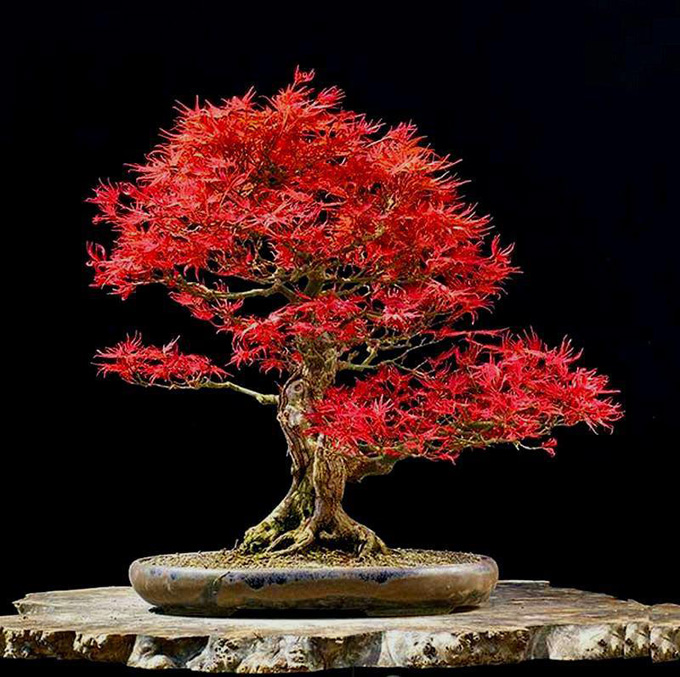 On fire. If you look closely, you can see a little reddish hue in the trunk, pot and even the soil. Does this mean this fiery thread leaf Japanese maple was color enhanced? My guess is, yes, it was. Unnecessarily so. If it were slightly less blazing, this would still be a beautiful bonsai. In fact, even if the foliage were green, the age and movement in the nebari, trunk and the rest of the tree, would be enough to qualify this tree as beautiful.
On fire. If you look closely, you can see a little reddish hue in the trunk, pot and even the soil. Does this mean this fiery thread leaf Japanese maple was color enhanced? My guess is, yes, it was. Unnecessarily so. If it were slightly less blazing, this would still be a beautiful bonsai. In fact, even if the foliage were green, the age and movement in the nebari, trunk and the rest of the tree, would be enough to qualify this tree as beautiful.
The pot is excellent too, though it’s difficult to tell if it’s round or oval. If it’s round, then placing the tree in the center would be in keeping with traditional (Japanese) guidelines on placement (traditionally speaking, you would also expect a glazed pot for a deciduous tree). If it’s oval, you would expect the tree to be off center a bit. But then, guidelines are simply guidelines.
Attribution free. The three photos in this post are from Bonsai Do (Argentina). Unfortunately, none are attributed. This is very common, especially on facebook. I’m never sure why people don’t bother, though I sometimes wonder if their motives are less than pure. In this case Bonsai Do does go to the trouble to explain that the tree’s are not theirs, though the information is posted in a spot removed from the photos (Las fotos son recopilaciones de libros, revistas y sitios de Internet, pertenecientes a maestros, aficionados y coleccionistas del Arte del BONSAI (The photos are from collections of books, magazines and websites that belong to teachers, enthusiasts and collectors of the Art of the BONSAI).
 All is forgiven if there are enough flowers (the rest of the year, a tree like this sits unnoticed on a back bench somewhere). There are few things more gorgeous than a Wisteria in full bloom. Let alone a Wisteria in a quality pot, in front of a gold screen and on a bright red rug (piece of satin?).
All is forgiven if there are enough flowers (the rest of the year, a tree like this sits unnoticed on a back bench somewhere). There are few things more gorgeous than a Wisteria in full bloom. Let alone a Wisteria in a quality pot, in front of a gold screen and on a bright red rug (piece of satin?).
 I have a soft spot for scenes like this. Especially when the feature tree is spectacular enough to easily stand on its own, and the slab works so well with the planting (check out the perfect color and texture match of the slab and the tree).
I have a soft spot for scenes like this. Especially when the feature tree is spectacular enough to easily stand on its own, and the slab works so well with the planting (check out the perfect color and texture match of the slab and the tree).
 It wasn’t my intention when I posted the Penjing planting above to promote this book, but once the thought arose, I couldn’t resist. The good news is that this book by Zhao Qingquan is truly an excellent, beautiful work of art. The best book on Penjing I’ve ever seen (and no, the photo immediately above the book, is not from the book).
It wasn’t my intention when I posted the Penjing planting above to promote this book, but once the thought arose, I couldn’t resist. The good news is that this book by Zhao Qingquan is truly an excellent, beautiful work of art. The best book on Penjing I’ve ever seen (and no, the photo immediately above the book, is not from the book).
Hi!
The first tree is from Walter Pall. The rest of them I don’t know. But the second one I believe I’ve seen it in some japanese bonsai exhibit.
Cheers!
Nuno
http://walter-pall.de/maplesjapanese_maple_nr__5.jpg.dir/index.html
Good job identifying that tree! I’m sure Mr. Pall would appreciate the credit for his work.
Thanks Nuno.
Strange that I missed Walter’s maple. But then, I’ve been missing stuff all along. Anyone else?
-w
Thanks Zack,
See my reply to Nuno. It just fell into a blank spot in my mind. We always try to attribute or state why we are not attributing.
-w
I agree: color boosted. Some films used to be so off-color: a lot of satsuki dictionary photos are too purple. Now, with digital imaging, it’s not a film artifact, but deliberate.
Howsoever, the maple is quite dense for a lace-leaf type… quite an accomplishment.
I have a vine in Florida for many years….it had one bloom last year and I was excited…hahahaha….geez what a spectacle
I find WP’s trees extremely recognisable – not least because of the black and/or grey backdrop.
Third one looks like it might be something from Robert Steven.
No Jerry, it’s not mine.
BTW, I love the second one, if someone happen to know to whom this belongs, please let me know as I want to use it in my next book. Tks.